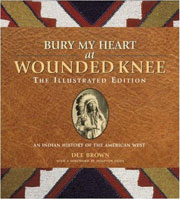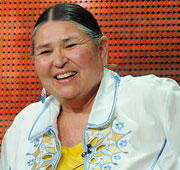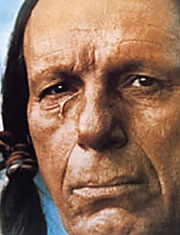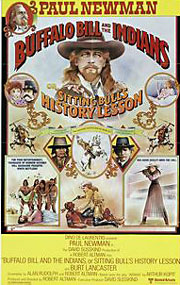|
There's a telling moment in the acclaimed 2009 documentary Reel Injun, in which an elderly Navaho gentleman watches an old clip of himself falling off a horse in an old John Ford western. He laughs it off, but in that instant you get a sense of how Hollywood for decades portrayed the Native American – a proud people reduced to savages playing their "parts" by falling off horses. In those old films, the Native American was seen as an impediment to progress. The white man had his Manifest Destiny and woe to him who got in the way of western expansion.
Growing up, I received mixed signals about Native Americans. On one hand, you had the benevolent Indians such as Squanto and Massasoit who were featured in elementary textbooks while on the other hand you had Natives like Crazy Horse and Geronimo excoriated as "troublemakers". There was the amiable, innocuous, monosyllable speaking sidekicks like Tonto but by and large, TV westerns always made me fearful of being scalped. TV Injuns scalped quickly and efficiently. They were also good with a bow and arrow. In a game of cowboys and Indians, well you never wanted to be the Indian. The cowboy was good and the Indian was evil. And that was that until one discovered that he shared something in common with those troublemakers, those evil doers, those rebels – he shared the same DNA. Yes, he also shared the same DNA with those who would suppress such renegades but he would begin to look at cowboys and Indians a lot differently.
And while the 60's produced prodigious change and turmoil for much of the country, the lives and concerns of the indigenous peoples were largely ignored.
But perceptions began to change concerning Native Americans beginning in the 70's. The groundbreaking book by Dee Brown Bury My Heart At Wounded Knee exposed a new generation to a more balanced view of history as it related to Native Americans.  The birth of the American Indian Movement (AIM) and their 71 day siege of Wounded Knee, South Dakota in 1973 garnered international attention. One who was paying close attention to those unfolding events was none other than Marlon Brando. Brando, who most will recall, was fresh off of his Oscar nominated performance for the Godfather. When the actual awards presentation was televised in March of that year, Brando did not attend. Instead, the actor orchestrated his nonattendance and his non-acceptance (he won best actor) as a vehicle to draw attention to what was happening at Wounded Knee and what he perceived to be the mistreatment and misrepresentation of native peoples by Hollywood. And while Brando didn't attend, he sent a proxy – Native American activist Sacheen Littlefeather (nee Marie Cruz) to turn down the award. She was tasked with reading a 15 page speech written by Brando but wasn't allowed to read that on stage (she later read that backstage to the press). The birth of the American Indian Movement (AIM) and their 71 day siege of Wounded Knee, South Dakota in 1973 garnered international attention. One who was paying close attention to those unfolding events was none other than Marlon Brando. Brando, who most will recall, was fresh off of his Oscar nominated performance for the Godfather. When the actual awards presentation was televised in March of that year, Brando did not attend. Instead, the actor orchestrated his nonattendance and his non-acceptance (he won best actor) as a vehicle to draw attention to what was happening at Wounded Knee and what he perceived to be the mistreatment and misrepresentation of native peoples by Hollywood. And while Brando didn't attend, he sent a proxy – Native American activist Sacheen Littlefeather (nee Marie Cruz) to turn down the award. She was tasked with reading a 15 page speech written by Brando but wasn't allowed to read that on stage (she later read that backstage to the press).  Her demeanor turned out to be the perfect antidote to the bravado and machismo of Brando. Some felt she was the proverbial skunk at the garden party, but this was no skunk. During her brief time on stage, she displayed class, dignity, politeness, eloquence, calm and a stunning beauty that surpassed the glitterati that was in attendance that night. A statement had been made, a message was sent. Brando knew what he was doing after all. Aim members who participated in that siege to this day credit Brando with helping to ease their plight and ultimately helping to bring a peaceful resolution to that powder keg. Unfortunately for Sacheen Littlefeather, her reputation would take a beating. Vicious rumors and attacks regarding her ethnicity (some claimed she was an imposter who wasn't Native American – she was) would derail a budding acting and modeling career. Today, Littlefeather is alive and well, having spent many years in a career involving health and nutrition utilizing Native American medicines. Currently she is coordinator for the Kateri prayer circle in San Francisco. She also promotes Native American film and appears in Reel Injun. Her demeanor turned out to be the perfect antidote to the bravado and machismo of Brando. Some felt she was the proverbial skunk at the garden party, but this was no skunk. During her brief time on stage, she displayed class, dignity, politeness, eloquence, calm and a stunning beauty that surpassed the glitterati that was in attendance that night. A statement had been made, a message was sent. Brando knew what he was doing after all. Aim members who participated in that siege to this day credit Brando with helping to ease their plight and ultimately helping to bring a peaceful resolution to that powder keg. Unfortunately for Sacheen Littlefeather, her reputation would take a beating. Vicious rumors and attacks regarding her ethnicity (some claimed she was an imposter who wasn't Native American – she was) would derail a budding acting and modeling career. Today, Littlefeather is alive and well, having spent many years in a career involving health and nutrition utilizing Native American medicines. Currently she is coordinator for the Kateri prayer circle in San Francisco. She also promotes Native American film and appears in Reel Injun.
It was during this same time period we still had the schism between the so called troublemakers and the benevolent Indian. On one hand you had the activist, militant AIM members and then on the other hand you had beloved figures like Iron Eyes Cody. Who could forget those memorable public service announcements of that time concerning pollution and littering? Who could forget that tear rolling down the cheek of Indian actor Cody as he surveyed all the damage white folks had committed to the environment in those iconic commercials.  Cody was a Hollywood veteran who appeared in many of those early films which helped stereotype an entire race of people. Now he was the public face of a culture and way of life that was increasingly being embraced as a means to save us from ourselves. I once read an autobiography of Cody and found his life and experiences in Hollywood fascinating. It was only recently that I discovered a startling fact about Cody, a fact that Reel Injun as well as other reputable sources has borne out – he wasn't Native American. He was born Espera Oscar de Corti and was of Sicilian descent. Cody died in 1999 but even in death, his web site maintains his Native American ancestry. Unbelievably, a Sicilian from Louisiana had become the ultimate Hollywood Indian. And while numerous non-natives portrayed natives in film, Cody took the appropriation of a race and culture to a different level entirely. Cody was a Hollywood veteran who appeared in many of those early films which helped stereotype an entire race of people. Now he was the public face of a culture and way of life that was increasingly being embraced as a means to save us from ourselves. I once read an autobiography of Cody and found his life and experiences in Hollywood fascinating. It was only recently that I discovered a startling fact about Cody, a fact that Reel Injun as well as other reputable sources has borne out – he wasn't Native American. He was born Espera Oscar de Corti and was of Sicilian descent. Cody died in 1999 but even in death, his web site maintains his Native American ancestry. Unbelievably, a Sicilian from Louisiana had become the ultimate Hollywood Indian. And while numerous non-natives portrayed natives in film, Cody took the appropriation of a race and culture to a different level entirely.
The 70's also brought a trio of films which changed the way I looked at cowboys and Indians. Too young to pay much attention to Little Big Man, Billy Jack, and Buffalo Bill and the Indians or Sitting Bull's History Lesson at the time they were released; later viewings of videos and DVDs gave me a greater appreciation of their import. Each of these films has maintained a cult status down through the years. Directors Tom Laughlin (Billy Jack), Arthur Penn(Little Big Man), and Robert Altman (Buffalo Bill) began to undo in dramatic fashion what Hollywood's old guard had perpetrated in regards to the depiction of native culture.
Billy Jack, originally released in 1971 is a film I intend to explore further in a future piece. Needless to say, it was one of the first films to depict a native character in a sympathetic light. Billy Jack was one bad MOFO. He took names and literally kicked ass with martial arts precision. A labor of love for director/actor Laughlin and wife Delores Taylor, the duo endured many hardships and struggles in order to bring the film to fruition.
The offbeat films Little Big Man and Buffalo Bill may at first seem odd choices as cinema that would change how the public would perceive American Indians. Both films lampoon and revise the "established" history of the old west. In so doing, these two films probably came closer to the truth of the Native American experience than any history book or previous film ever could.  Paul Newman would star as Buffalo Bill Cody in perhaps one of his most brilliant if not unheralded roles of his career. Cody's late 19th century Wild West Shows were a forerunner of what was to show up in the next century's western films. Altman excels in exploring fame, celebrity, and human frailty in this great film. At the time of its release in 1976 the film flopped due in no small part to the nation's bicentennial. The nation was in no mood to consider a revision of history. Dustin Hoffman was also brilliant in his role as Jack Crabb, a 121 year old veteran of the Wild West who looks back upon his life. Some critics would even go as far as to interpret the film (based on a novel by Thomas Berger) as a commentary on the Vietnam War. That may have been some of Penn's intent, but to his credit the film's main focus is a look at the history of the Old West and the role of Native Americans in it. Along with changing attitudes, these films also exposed filmgoers to the talents of native actors Chief Dan George (Old Lodge Skins in Little Big Man) and Will Sampson as William Halsey in Buffalo Bill. Some may also remember Sampson's amazing performance as Chief Bromden in One Flew Over the Cuckoo's Nest. Paul Newman would star as Buffalo Bill Cody in perhaps one of his most brilliant if not unheralded roles of his career. Cody's late 19th century Wild West Shows were a forerunner of what was to show up in the next century's western films. Altman excels in exploring fame, celebrity, and human frailty in this great film. At the time of its release in 1976 the film flopped due in no small part to the nation's bicentennial. The nation was in no mood to consider a revision of history. Dustin Hoffman was also brilliant in his role as Jack Crabb, a 121 year old veteran of the Wild West who looks back upon his life. Some critics would even go as far as to interpret the film (based on a novel by Thomas Berger) as a commentary on the Vietnam War. That may have been some of Penn's intent, but to his credit the film's main focus is a look at the history of the Old West and the role of Native Americans in it. Along with changing attitudes, these films also exposed filmgoers to the talents of native actors Chief Dan George (Old Lodge Skins in Little Big Man) and Will Sampson as William Halsey in Buffalo Bill. Some may also remember Sampson's amazing performance as Chief Bromden in One Flew Over the Cuckoo's Nest.
Some consider Kevin Costner's 1990 Dances With Wolves a major breakthrough as it relates to the portrayal of Native Americans in film. The sympathetic portrayal with more rounded characters was indeed an improvement over past efforts but activist/native musician John Trudell summarizes the film as basically being "about a white guy". The natives are once again used as a back drop. The film did however showcase the acting talents of native actor Graham Greene. Greene is simply fabulous in any role he decides to undertake, including non-native ones. And that ability is perhaps the ultimate benchmark for Native actors. As for Native American film, well it certainly has evolved with more opportunities and meatier roles. What makes a film native? Well, Scene4 contributor Carole Quattro Levine has addressed that question before in past commentary and I like her take as to what is native film with the wonderful examples she cites. What has also evolved over the years is acclaimed writers and filmmakers like Sherman Alexie and Neil Diamond (not the singer) who bring credibility and the native experience to their projects. And while Alexie tackles new schisms such as reservation versus urban Indians, it's hard to deny real progress hasn't taken place. This new group of talent can even poke fun at and play around with old stereotypes. An excellent companion piece along side Diamond's Reel Injun is Sandra Schulman's book Honest Injun (Hollywood, History, and the Great White Lie). What does the future hold for Native American film? Fortunately, Native Americans will have a big say in that future.
|

